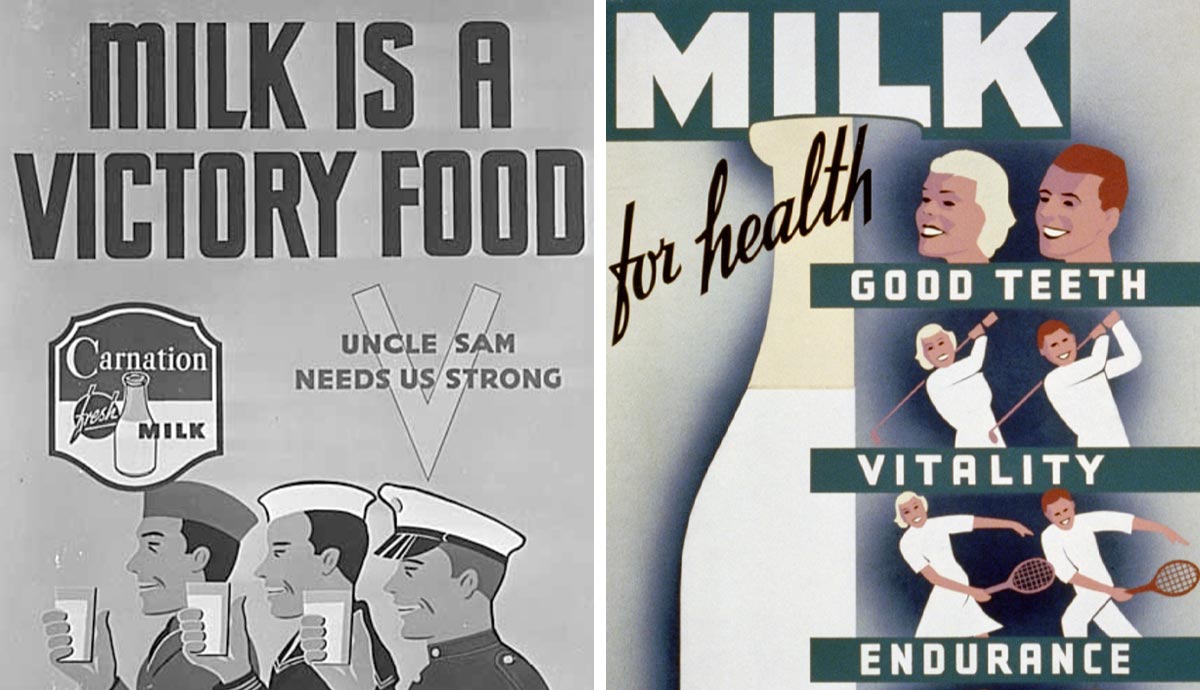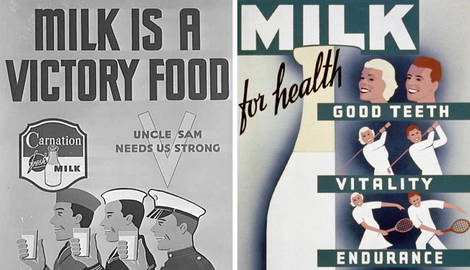
For generations, Americans have subscribed to the belief that consuming milk has an abundance of health benefits, including weight management and stronger bones. The United States government maintained that drinking two to three servings of milk every day was healthy. Milk was touted to be a Victory Food during wartime and had even been made a compulsory item in school lunches since the 1940s. How true were these claims that have been strongly backed by the government and aggressively marketed via the media throughout the 20th century?
Humans Have Been Consuming Milk for a Long Time

Was milk really helping to build a healthier America or was it mere propaganda manufactured to protect or enable the massive dairy industry? Let’s delve into the politics and uncover the economics behind America’s most culturally defining beverage.
The practice of animal milk drinking is said to date as far back as 9,000 years ago. Close examination of ancient pottery shards discovered in Turkey found hints of milk fats, leading archaeologists to believe that milk had been a staple of the diet of early settlers. Researchers who analyzed ancient dental plaque have also confirmed human consumption of goat milk in East Africa some 6,000 years back. Ancient Egyptians consumed cow milk and goat milk while using donkey milk for medicinal purposes. During the Bronze Age, around 3,000 years ago, humans were using cow milk to feed their newborns, which is evident from traces of milk found on the pots. Later, milk became a staple for pastoral empires in the likes of the Xiongnu and the Mongols.
We Were Biologically Intolerant of Milk

Adult humans were not made to drink a lot of milk, at least not without spending a considerable amount of time in the toilet afterward. Milk contains a sugar called lactose, which is only digestible with a unique enzyme called lactase that is produced by babies before weaning. Adult humans were not capable of producing lactase and therefore could not properly digest lactose. However, with generations of genetic mutation and evolution, in some parts of the world today humans are lactase persistent—meaning their bodies can easily digest milk sugars. As opposed to their Asian and African counterparts, more than 90% of Northern Europeans are lactase persistent.
Enter The Game Changer: Pasteurisation

One major historical downside to milk was that it went bad quickly. That explained why our predecessors would rather use milk to make sour yogurt, butter, and cheese. While some tried to extend the shelf life of milk by lowering it down wells to keep it cold, few managed to make it last long. It would take pasteurization in the mid-19th century to truly change the name of the game for milk. In the 1860s, French chemist and microbiologist Louis Pasteur heated wine and beer up to 50–60°C and cooled them down, killing harmful microorganisms while leaving those that caused fermentation. Pasteur’s groundbreaking technique was applied to dairy products and helped prevent them from going bad quickly. This made for safe mass production and laid the foundations for a flourishing dairy industry.

It was only in the 1920s and 1930s that pasteurization became widespread, accelerating the growth of the dairy industry, particularly in the United States. Before that, raw milk was known to contain harmful bacteria such as Salmonella and E. coli. With pasteurization, the risk of diseases transmitted through raw milk was vastly reduced, leading to an improvement in public health. At the same time, consumer confidence was boosted as more and more people trusted the rigorous process of ensuring the safety and hygiene of milk products. As pasteurization became an industry norm with the governmental mandate, it contributed to the improved shelf life and standardized the quality of the milk that was being produced and distributed.
The Rise of Milk: Supporting the War Effort

However, even before pasteurization became mainstream, milk was being promoted by the United States government as safe and nutritious to consume (as food and not a beverage). During the early 20th century, the United States Food Administration ran countless campaigns highlighting the health benefits of consuming milk. Milk was marketed as a square meal—convincing Americans that milk made for an adequate meal since it contained butter fat, sugar, protein, and mineral salts. Some of these campaigns—especially those created during World War I—were even stretching the messaging to encompass national identity and patriotism.

At the same time, another war-related factor was fueling the rise of milk. To support the Allied Powers on the European front, the United States government sent milk in canned and powdered forms to soldiers overseas. To meet the increased demand, dairy farmers ramped up milk production. Not only did they forsake other forms of farming to concentrate on milk, but they also invested capital into the latest technology to aid milk production. This would later lead to a sticky situation after the war—a surplus of milk with no one to sell it to, even with ridiculously cheap prices.
Surviving the Surplus Situation

Exacerbated by the Great Depression, the surplus problem forced desperate farmers to stage multiple strikes throughout the 1930s to agitate for better milk prices. During that time, milk per quart was sold at 10 cents, of which 3.76 cents would go to farmers. Distributors refused the farmers’ demand for higher milk prices, arguing that the public would not buy it. In retaliation, farmers went on strikes, poured gallons of milk on the ground, and sabotaged milk deliveries. To appease the farmers, the government had no choice but to step in with federal programs and policies to create artificial demand.

The Federal Milk Program for Schools, or School Milk Program, started in 1940 when milk was distributed to low-income schools at highly subsidized rates. Those who could not afford to pay received milk for free. Later, the 1946 National School Lunch Act made it compulsory for every lunch in school to include whole milk. While it appeared that the government was shoving milk down people’s throats, they maintained that their sole objective was to reduce malnutrition and hidden hunger among American schoolchildren. The slogan was that the School Milk Program was “Building a Stronger America.”
World War II & Milk Propaganda Part Two

Having experienced the success of milking wartime uncertainty and patriotism, the United States government replicated the formula during World War II. Propaganda materials repeatedly highlighted the nutritional value of consuming milk as it contained calcium, vitamin D, and protein. Civilians were also encouraged to drink more milk not only as a healthy food choice but also to support the war effort.

Posters and advertisements of the time often featured soldiers and celebrities consuming the Victory Food in an attempt to influence the everyday consumer. The government dished out nutritional advice that recommended two to three servings of milk daily, and by 1945, the average American was consuming almost 45 gallons of milk a year. Relentless propaganda had successfully ingrained the sacred existence of milk in the American psyche—it was almost like milk flowed in the blood of all Americans.
Hello Surplus, My Old Friend

Decades of marketing and bombarding people with nutritional messages might have changed American dairy consumption patterns. However, the pattern of the government bailing the dairy farmers out did not change, as history would repeat itself in the late 1970s. During the economic downturn, the agricultural sector faced destabilizing challenges such as inflation and high interest rates. Then-U.S. President Jimmy Carter came to the rescue of the struggling farmers, dedicating up to US $2 billion in the form of subsidies, price supports, and other financial assistance. As a result, farmers became rich overnight and were incentivized to ramp up milk production.
Facing a surplus, the government had to buy tons of unsold milk, but this time, they chose to process it into cheese, butter, and even dehydrated milk powder. This led to the infamous, pungent-smelling Government Cheese of the 1980s that Americans would hate to be reminded of. A far cry from the intricately crafted artisan cheeses from Europe, the American Government Cheese came in the form of a pale-orange, five-pound block of processed sadness. However, instead of letting some 300 million pounds of cheese turn moldy, the government packaged them as part of a Temporary Emergency Food Assistance Program where the surplus cheese would be given to the elderly or low-income groups.
Make America’s Milk Great Again

As American milk consumption continued to dip throughout the 1980s, the billion-dollar dairy industry was at risk of collapsing. Desperate, the United States government hired top-tier marketing agencies and experts to run campaigns to increase milk demand. This birthed the famous Got Milk? advertisements, arguably one of the most iconic marketing campaigns ever to grace the TV screens and magazines of the United States.
People who grew up in the 1990s would remember seeing peculiar government-sponsored commercials of characters consuming milk to clear their throats from sticky or dry foods. Print ads with celebrities from Jennifer Aniston to Britney Spears sporting milk mustaches were another unforgettable trademark of the campaign. Across the nation, the Got Milk? slogan was printed on numerous toys and product boxes such as cereals and cookies. Despite the success of the aggressive campaign, milk consumption increased only in California and not across America.
Milk in the Era of Plant-Based Alternatives

As new research emerged over the years, findings that ran counter to what the government has been claiming for the past century gained traction. Heavy in caloric and saturated fat content, milk has been linked to weight gain and cardiovascular diseases. Other studies also criticized the unethical nature of exploitative dairy farming and its associated environmental concerns. As a result, Americans’ opinion of milk today has shifted significantly. Some have relocated entirely to the plant-based milk camp, praising healthier and less fatty options in the market today such as oat milk, coconut milk, and soy milk. Others have sworn off whole milk while decrying the cow milk propaganda of the 20th century and calling it a government conspiracy.

Best known for the provocative book Got Milked? The Great Dairy Deception and Why You’ll Thrive Without Milk, author Alissa Hamilton strongly endorsed the argument. She is one of the most vocal commentators on America’s twisted love affair with milk. In her book, she detailed the unfounded government health claims, relentless official propaganda throughout the years, as well as calcium-rich food alternatives that are better than milk. More significantly, Hamilton highlighted the jarring conflict of interest when we have the government supposedly coming up with health guidelines and endorsing the massive dairy industry at the same time. Today, the whole milk versus plant-based milk battle continues to rage on. As influential dairy lobbies and the United States government stand firmly by their century-old proposition on the various health benefits of whole milk, consumers are left to tread the fine line between state-endorsed propaganda and the increasingly divided public opinion.










